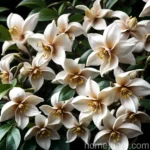Wintersweet (Chimonanthus praecox): A Delightful Winter-Flowering Plant
Introduction
When the cold, gloomy days of winter seem to have engulfed the garden in dullness, there shines a bright and fragrant delight known as the wintersweet (Chimonanthus praecox). This charming shrub not only adds a pop of color but also fills the air with a sweet, intoxicating fragrance during the winter months. In this comprehensive guide, we will delve into the captivating world of wintersweet, covering everything from its cultural requirements, uses, and maintenance to its significance in various cultures and its ecological role.
What is Wintersweet (Chimonanthus praecox)?
Wintersweet, scientifically known as Chimonanthus praecox, is a deciduous shrub that belongs to the family Calycanthaceae. This plant is native to China and has been cherished for centuries for its remarkable ability to bloom in the depths of winter. The delicate, waxy flowers of the wintersweet emit a captivating fragrance that can uplift the spirits on even the dreariest of days. With its rich history, folklore, and medicinal uses, this plant holds a special place in the hearts of many cultures around the world.
Key Takeaways – Wintersweet (Chimonanthus praecox)
Before we delve into the detailed aspects of caring for wintersweet, let’s highlight some key takeaways about this enchanting plant.
- Plant Name: Wintersweet (Chimonanthus praecox)
- Hardiness Zones: 7-9
- Mature Height: 6-10 feet
- Bloom Time: Winter to early spring
- Fragrance: Strong, sweet, and spicy
- Flower Colors: Pale yellow to rich maroon
- Cultural Significance: Symbolism and folklore in various cultures
- Ecological Role: Attracts pollinators during winter, wildlife habitat
Culture
Understanding the cultural requirements of wintersweet is essential for successfully cultivating this charming shrub in your garden.
Uses
Wintersweet offers a myriad of uses, ranging from ornamental and medicinal to ecological and symbolic. Its sweet fragrance and vibrant blooms make it a captivating addition to any garden or landscape. The flowers can be used in floral arrangements to bring a touch of winter elegance indoors. In traditional medicine, various parts of the plant have been used for their medicinal properties, including treating conditions such as inflammation and pain.
Water
Wintersweet prefers consistently moist soil, especially during the growing season. However, it is essential to ensure good drainage to prevent waterlogged conditions, which can be detrimental to the plant’s health.
Sunlight
This shrub thrives in partial to full sunlight. While it can tolerate some shade, ample sunlight is essential for robust flowering and overall plant health.
Fertilizer
When it comes to fertilizing wintersweet, a balanced, slow-release fertilizer applied in early spring can provide the necessary nutrients for healthy growth and abundant flowering. It is crucial to follow the recommended application rates to prevent over-fertilization, which can lead to excessive foliage at the expense of flowers.
Soil
Wintersweet prefers well-drained, slightly acidic to neutral soil. Amending the soil with organic matter can improve its structure and fertility, creating an optimal environment for the plant to thrive.
Pruning
Pruning wintersweet is best done after flowering to avoid compromising the next season’s blooms. Remove dead or damaged wood and maintain a balanced shape to encourage healthy growth and flowering.
Propagation
Wintersweet can be propagated from semi-hardwood cuttings taken in late summer or early autumn. Rooting hormone can aid in the success of the cuttings, which can then be transplanted once established.
Container Popularity
The compact nature of wintersweet makes it well-suited for container cultivation. Its delightful fragrance and charming blooms can adorn patios and small garden spaces, bringing cheer to the winter landscape.
Common Diseases and Pests
While wintersweet is relatively resistant to pests and diseases, there are a few common issues to watch out for. Proper cultural practices, such as providing adequate airflow and avoiding excessive moisture on the foliage, can help prevent these problems.
Diseases
- Powdery Mildew: This fungal disease can affect wintersweet, especially in conditions of high humidity and poor air circulation. Pruning to improve airflow and applying fungicidal treatments as necessary can help manage powdery mildew.
- Leaf Spot: Certain fungal pathogens can cause leaf spotting on wintersweet. Maintaining good sanitation and avoiding overhead watering can reduce the risk of this issue.
Pests
- Aphids: These tiny insects can sometimes infest wintersweet, sucking sap from the plant and causing distortion or discoloration of the foliage. Natural predators, such as ladybugs, can help control aphid populations, but if necessary, insecticidal soaps or horticultural oils can be used for management.
Botanist’s Tips
To ensure optimal care for your wintersweet and witness its stunning blooms in the winter garden, consider the following tips:
- Mulching: Applying a layer of organic mulch around the base of the plant can help conserve soil moisture and moderate soil temperature.
- Winter Protection: In colder climates, providing some protection from harsh winter winds can prevent damage to the plant. Wrapping the shrub with burlap or erecting windbreaks can be beneficial.
- Regular Inspection: Periodically inspecting the plant for signs of pests, diseases, or nutrient deficiencies can help address any issues promptly, ensuring the plant’s health and vigor.
Fun Facts
Delve into some intriguing and delightful fun facts about wintersweet:
- The flowers of wintersweet are often used in herbal teas and potpourri, infusing the air with their sweet fragrance.
- In Chinese culture, wintersweet holds symbolic significance and is associated with perseverance and hope during difficult times.
Now that we have acquainted ourselves with the cultural, horticultural, and ecological aspects of wintersweet, let’s explore some external resources that can further enrich our understanding of this captivating plant.
Links to External Resources
- Royal Horticultural Society – Chimonanthus praecox
- Missouri Botanical Garden – Wintersweet
- University of Maryland Extension – Winter Plants for Fragrance
- American Society for the Prevention of Cruelty to Animals – Toxic and Non-Toxic Plants: Wintersweet
As we continue to explore the alluring realm of plants, may the beauty and resilience of wintersweet inspire us to find joy and vibrancy even in the coldest of seasons.















